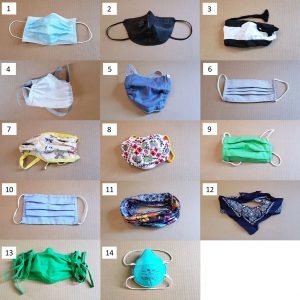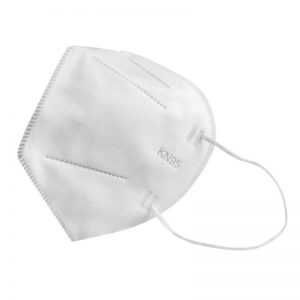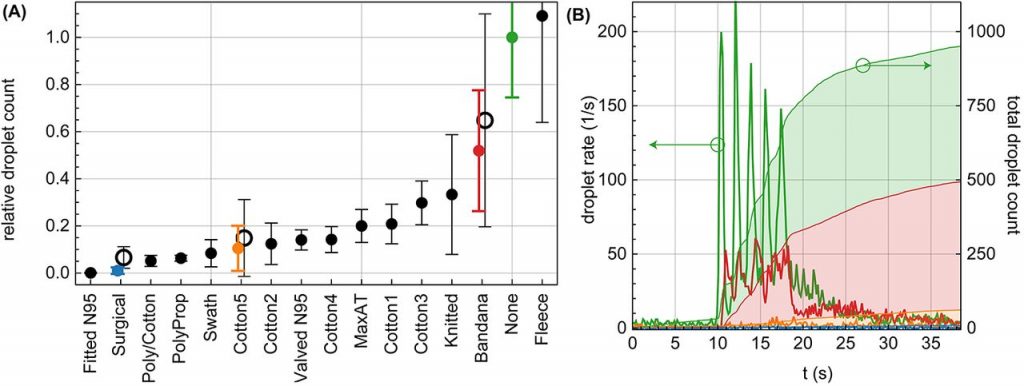The World Health Organization (WHO) recommends that everyone 60 years or older and everyone with underlying comorbidities like diabetes, heart or vascular disease, and immunosuppression should wear a medical-grade facemask, such as N95 or KN95. Read the WHO’s Do’s and Don’ts for wearing a mask. Read below for an overview of facemask options for COVID.
 Woven fabric face coverings: Any fabric that you can see light through will not protect you or those around you. In an August 7, 2020 article in Science Advances, Duke University researchers evaluated 14 different mask materials for their ability to stop aerosol particles from the mouth while people were speaking. The masks they tested are shown in the graphic to the right. Handkerchiefs, fleece balaclavas (cold-weather gear that covers the entire face except for the eyes) offered little protection. Even worse, neck gaiters (tubes of performance fabric typically used for running outdoors) actually break large aerosol particles down into small ones that can penetrate deeper into the lungs. N95 masks proved to be most effective.
Woven fabric face coverings: Any fabric that you can see light through will not protect you or those around you. In an August 7, 2020 article in Science Advances, Duke University researchers evaluated 14 different mask materials for their ability to stop aerosol particles from the mouth while people were speaking. The masks they tested are shown in the graphic to the right. Handkerchiefs, fleece balaclavas (cold-weather gear that covers the entire face except for the eyes) offered little protection. Even worse, neck gaiters (tubes of performance fabric typically used for running outdoors) actually break large aerosol particles down into small ones that can penetrate deeper into the lungs. N95 masks proved to be most effective.
Cotton and silk face coverings: Worn correctly, masks with three layers of closely-knit cotton or silk are effective at reducing the spread of COVID-19. They protect you and protect others while reducing the likelihood that you might touch your face. These can be made from fabrics such as silk scarves, or cotton t-shirts, sweatshirts, or towels. They should cover your nose and mouth where the virus enters and exits.
DIY masks: Homemade, locally made, and small manufacturer facemasks vary tremendously in their protective ability. How they fit the face, the fit’s snugness, and the quality of the materials from which they are made are critical. At least 3 layers are required:
- an inner white hydrophilic layer that absorbs moisture from your mouth and nose
- a middle polypropylene fabric layer for fine filtering
- a hydrophobic other layer that repels any outside moisture in the air.
View the WHO’s instructions for making DIY masks below.
Surgical masks: These reduce the number of potential contaminants that mask wearers release into the immediate environment. An elastic earloop fits different face shapes and makes it easy to put on and take off. These loose-fitting masks protect against larger droplets, but cannot reliably protect against smaller airborne particles.

KN95 masks: These masks filter out at least 95% of airborne particles that are larger than 0.3 microns. This includes many particles smaller than 10 microns that remain airborne longer and travel over greater distances in the air, as well as nearly all particles larger than 10 microns. In general, the small a particle, the lower its viral load. A KN95 mask provides optimal protection against a viral infection when it is worn.
The FDA has approved using Chinese-approved KN95 masks to replace the U.S. medically approved N95 masks when a shortage exists. The only minor difference between the masks is that American-manufactured N95 masks sometimes withstand a slightly stronger pressure when someone inhales and exhales due to a slightly tighter fit. The fit of a mask and its optimal use is important in medical situations, as well as for anyone who may be exposed to the Covid-19 virus.
How well do N95 and KN95 masks filter very small particles like the coronavirus, which is around 0.1 micron? Masks that filter tiny particles are always your best protection. N95 and KN95 masks filter 95% of particles that are 0.3 microns or larger. In theory, this efficiently filters out most viral particles expelled from the mouth or nose. Again, in theory, most of the smallest individual viral particles would also be filtered out. Mario Cuomo, mayor of New York City, points out that medical personnel who wear N95 masks while caring for patients with COVID-19 have lower rates of infection than the general population of New York City.

N95 masks: Like KN95 masks, these provide the best protection to both the wearer and others against the virus. They reduce a wearer’s exposure to at least 95% of airborne particles. Each can be reused until it gets dirty or damaged.
N95 masks with air valves: Valved N95 masks make it easier to exhale air, and are more comfortable to wear with less moisture build-up. Unfortunately, valved respirators do not filter the wearer’s exhaled air, only the inhaled. This one-way protection puts others around the wearer at risk. If the wearer has COVID-19, others around them can get it. For this reason, medical practices do not use valved respirators. If you wish to have easier breathing and also protect others, you can wear a valved KN95 mask, and simply place a surgical mask or cotton fabric over it to filter your outgoing breaths.
Correct Steps for Wearing a Mask
- Wash your hands with soap and water or use sterilizer on the hands.
- Put on the mask to cover your (or your child’s) nose and mouth, then stretch it gently over the chin.
- Press the thin metal wire along the upper edge gently against the bridge of your (or your child’s) nose so that the mask fits well on the face.
- Do not remove the mask when coughing or sneezing.
- Limit the amount of talking when wearing a mask to lower the amount of condensation produced and to extend mask life.
- Change your (or your child’s) mask when it becomes wet, soiled or damaged, or breathing becomes difficult. Touch only the straps and not the surface of the mask when removing it.
- Wash your hands after removing and disposal of a used mask.
- Do not reuse masks when contaminated.
Our Facemask Options for COVID
Take a look at our selection of facemask options for COVID, as well as thermometers, oximeters, or other Personal Protection Equipment (PPE) at the Diabetes Mall.
